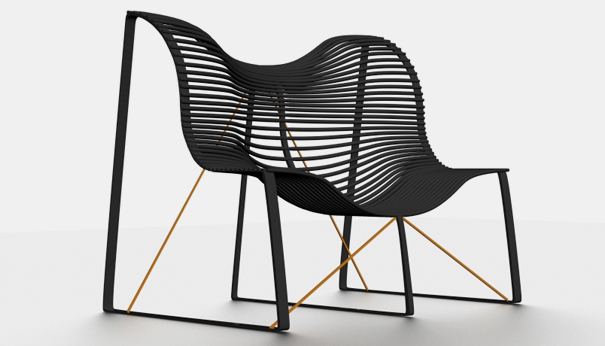Loginoff’s Anomaly: Hitchcock Meets Alice in Wonderland
What’s so anomalous about the Anomaly Bench? If you were to ask designer Dima Loginoff—Russian by ethnicity, designer by inclination, and sublime stylist of the curvaceous and the serpentine—I suppose the answer would be several-fold. He might comment on the steel construction, remarking that so few residential furnishings feature exposed metal ribs.
Anomaly Bench. Designed by Dima Loginoff.
Or perhaps he’d call attention to its perspectival gamesmanship, suggesting that the undulating metal slats and synchronized spacing between same gives the piece a kind of multiple personality, demanding different interpretations depending on where the viewer stands; or maybe he’d just shrug his shoulders with the practiced bonhomie of a contemporary aristocrat, the non-chalance of the gesture suggesting impatience with such inquiries, while communicating quite definitively, “make of it what you will.”

The latter scenario works best for me. Not only since much of the practice of naming (in art, design, or some synthesis of the two) involves a kind of genial tomfoolery at best—and malicious misdirection at worst—but since, not having the benefit of his bodily presence, that’s just how I prefer to imagine him: whiling away the hours between projects in some musky Muscovian haunt, perhaps in thrall to a routinized absinthe-laden stupor. I refer to Wilde’s “Green Fairy” in the best spirit of irreverent appreciation, since Loginoff’s portfolio (earlier gems include the Bone Lounge and Vassili) seems straight from the pages of Alice in Wonderland, such is the scope of his brand of whimsical surrealism.
The Anomaly Bench is a worthy addition. Like both Bone Lounge and Vassili, Anomaly is invested in the surprising shape, the unanticipated turn. With Bone Lounge, this was accomplished via the “torqued” portfolio of the entire piece—a choice that, in addition to facilitating a convincing facsimile of my chocolate lab’s favorite worldly object, evokes a kind of Hitchcockian inversion. Something similarly unsettling is at work in Anomaly, whose simplistic structure belies the degree of action on display. The piece creates a pronounced illusion of multi-directional movement, the slat’s undulations and three-dimensionality establishing an interesting interplay between positive and negative space. All said, Anomaly is just such an anomalous creature. As to the piece’s functionality, I’ll let Loginoff’s subsequent patrons (the piece is not yet in active production) have the word on that. But to the eye of a budding Internet connoisseur, it looks like a most sublime sit.




Leave a Reply